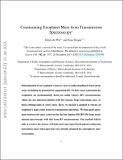Constraining Exoplanet Mass from Transmission Spectroscopy
Author(s)
de Wit, Julien; Seager, Sara
Download1401.6181.pdf (3.962Mb)
PUBLISHER_POLICY
Publisher Policy
Article is made available in accordance with the publisher's policy and may be subject to US copyright law. Please refer to the publisher's site for terms of use.
Terms of use
Metadata
Show full item recordAbstract
Determination of an exoplanet's mass is a key to understanding its basic properties, including its potential for supporting life. To date, mass constraints for exoplanets are predominantly based on radial velocity (RV) measurements, which are not suited for planets with low masses, large semimajor axes, or those orbiting faint or active stars. Here, we present a method to extract an exoplanet's mass solely from its transmission spectrum. We find good agreement between the mass retrieved for the hot Jupiter HD 189733b from transmission spectroscopy with that from RV measurements. Our method will be able to retrieve the masses of Earth-sized and super-Earth planets using data from future space telescopes that were initially designed for atmospheric characterization.
Date issued
2013-12Department
Massachusetts Institute of Technology. Department of Earth, Atmospheric, and Planetary Sciences; Massachusetts Institute of Technology. Department of PhysicsJournal
Science
Publisher
American Association for the Advancement of Science (AAAS)
Citation
de Wit, J., and S. Seager. “Constraining Exoplanet Mass from Transmission Spectroscopy.” Science, vol. 342, no. 6165, Dec. 2013, pp. 1473–77.
Version: Author's final manuscript
ISSN
0036-8075
1095-9203